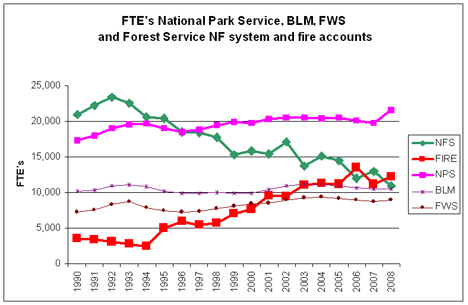NAFSR Budget Recommendations for the USFS FY2009 Budget
George M. Leonard - Chairman, Board of Directors, National Association of Forest Service Retirees (NAFSR)
Recommendations to the Subcommittee on Interior, Environment, and Related Agencies Regarding the FY2009 Budget for the U.S. Forest Service
Full text [here]
Selected excerpts:
The following recommendations relate to all programs of the U.S. Forest Service. In developing these recommendations, we used the FY2008 Omnibus appropriation, as enacted, as the starting point. We find the Administration’s FY2009 budget proposals for the Forest Service to be irresponsible. We believe the base funding for all programs should be the FY2008 appropriation level adjusted for pay act and other uncontrollable costs (an increase of $77 million across all program areas). …
The most critical issue that needs to be addressed in the Forest Service budget is the funding of fire suppression. The current procedure of including the ten-year average cost of fire suppression within the agency’s discretionary budget is destroying the capability of the Forest Service to carryout the remainder of its statutory missions. From 25 percent in FY2000, fire funding is now approaching 50 percent of the budget. The suppression cost trend means the ten-year average is going to continue to grow, further cannibalizing funding for other programs. While the overall Forest Service budget has increased nine percent over the last six years, the diversion of funds to fire suppression has had a major impact on the workforce available to carry out the multiple-use mission of the agency. The number of foresters, biologists, and other resource specialists, along with supporting technicians, is a good measure of the capability of a resource management agency to carry out its mission. As illustrated in the following table, the capability of the Forest Service has been seriously compromised. …
There is wide spread recognition of the need to thin our overstocked forests to reduce their vulnerability to fire, insects, and disease. Funding for hazardous fuel reduction is important and must be continued, but it is only scratching the surface. Annual growth on the currently roaded portion of the timberlands on the National Forests is about 4 billion cubic feet. Not all of the material that needs to be removed has economic value, but portions are suitable for conventional wood products. Much more is suitable for energy production, including ethanol. Capturing these economic values is essential for making real progress in improving the conditions of our forests. It can also contribute to meeting our energy needs. …
One of the primary purposes for which the National Forests were established is to provide favorable conditions of water flow. Our forested watersheds provide much of the water that meets the needs of our growing population, particularly in the West. Resource management specialists and supporting technicians available to protect and enhance our watersheds have declined by 44 percent in the last six years. This decline must be reversed. …
The National Association of Forest Service Retirees believes that the National Forests and Grasslands should be managed so they are an asset to the communities within and adjacent to these lands. In too many instances, rather than being an asset, the overstocked, insect-infested, poorly maintained, understaffed Forests are becoming a liability. We believe the funding increases recommended above will begin the process of restoring the capability of the Forest Service to provide proper stewardship for these national treasures.

